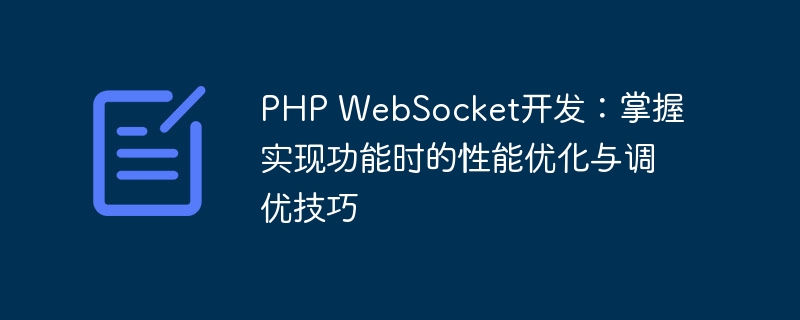

PHP WebSocket Development: Master the performance optimization and tuning skills when implementing functions
With the development of Web applications and the increasing demand, the demand for real-time communication is also becoming more and more important. PHP is a widely used server-side programming language. Its elegance and flexibility make it the first choice of many developers. In PHP, WebSocket is a protocol for full-duplex communication, which provides a real-time communication solution.
However, when implementing WebSocket functions, we often face performance optimization and tuning challenges. This article will introduce some common performance issues and provide some optimization and tuning tips to help developers better master PHP WebSocket development.
1. Reduce network requests
In WebSocket development, every communication with the server will involve network requests, and the number of network requests is an important factor affecting performance. Therefore, we need to minimize the number of network requests.
First of all, you can consider using long connection technology. Unlike traditional short connections, long connections can maintain a continuous connection with the server, avoiding the need to establish and close the connection for each request. By maintaining long connections, the overhead of establishing and closing connections can be significantly reduced and performance improved.
Secondly, batch processing can be used. That is, multiple requests are merged into one request for processing. This can reduce the number of network requests and improve performance. For example, for a real-time chat application, multiple messages can be merged into one request and sent to the server, reducing the number of requests and improving performance.
2. Use cache
Cache is one of the important means to improve performance. In WebSocket development, caching can also be used to improve performance.
Specifically, you can store some frequently accessed data through caching to avoid reading data from a database or other storage media for every request. This can greatly reduce the overhead of data reading and improve performance. For example, for a real-time stock quotation application, the real-time quotation data can be cached for sharing by multiple users.
In addition, cache can be used to store some intermediate calculation results. For example, for an application that requires frequent calculations, some calculation results can be cached and the results in the cache can be used directly when needed next time to avoid repeated calculations and improve performance.
3. Use asynchronous operations
Normally, the processing in WebSocket development is single-threaded, that is, there is only one thread responsible for processing all client requests. In this way, when a request takes a long time to get a response, it will block the processing of other requests and reduce performance.
In order to improve performance, you can consider using asynchronous operations. Asynchronous operations can be performed in the background without blocking the processing of other requests. For example, you can use PHP's asynchronous IO extension to perform IO operations to avoid blocking and improve performance. In addition, you can use an asynchronous task queue to handle time-consuming computing tasks, and hand over the computing tasks to the background for processing to avoid blocking.
4. Clean up resources regularly
In WebSocket development, the use of resources is inevitable. However, if resources are not cleaned up in time, it will lead to resource constraints and thus affect performance.
Therefore, we need to clean up resources regularly. For example, you can regularly clean up invalid connections and release occupied resources. In addition, you can regularly clean up cached data that is no longer needed to free up memory.
Summary:
Performance optimization and tuning are very important in WebSocket development, which can improve the response speed and stability of the program. By reducing network requests, using cache, using asynchronous operations and regularly cleaning up resources and other techniques, we can better master performance optimization and tuning methods when implementing WebSocket functions. At the same time, developers should also choose appropriate optimization and tuning methods based on specific application scenarios and needs. Only by continuous learning and practice can we continuously improve our technical level in WebSocket development and write high-performance programs.
The above is the detailed content of PHP WebSocket development: Master performance optimization and tuning skills when implementing functions. For more information, please follow other related articles on the PHP Chinese website!




